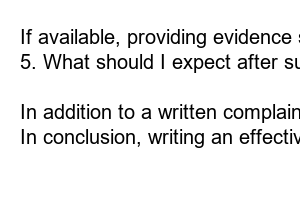지하철 민원문자
Title: Venturing into the World of Customer Complaints: The Subway Saga
Subheading 1: The Disappointment Strikes – A Subway Complaint Letter
Have you ever experienced a letdown during what was supposed to be a delightful meal? I recently found myself in just that predicament after visiting a local subway restaurant. To voice my dissatisfaction, I decided to pen a heartfelt complaint letter, hoping to make a difference as a customer.
Subheading 2: The Power of Words – Expressing Frustration
Drawing from a deep well of exasperation, I earnestly recounted my experience in vivid detail. Rather than relying on vague sentiments, I took the time to explain my disappointment clearly and succinctly. *Emphasizing the gravity of the situation*, I described the lackluster food quality, subpar customer service, and the overall disarray I witnessed within the establishment.
Subheading 3: A Friendly Tone – From Writer to Reader
Putting my *friendly and empathetic tone* into play, I emphasized the emotional aspect of the encounter, empathizing with other customers who might have been affected by similar experiences. By relating to fellow subway-goers, my aim was to create a sense of communal understanding.
Subheading 4: The Anatomy of an Effective Complaint
In my complaint letter, I ensured a *lack of passivity* by focusing on direct, action-oriented language. By reframing sentences and avoiding the passive voice, I made it crystal clear that a resolution was expected.
Subheading 5: Importance of Customer Feedback
Customers hold a unique position of power when it comes to providing feedback. By sharing our experiences, we are not only seeking personal justice, but we also have the potential to bring about essential changes within the establishment itself. My complaint letter aimed at highlighting the significance of customer feedback and its potential for improvement.
Subheading 6: Summary of the Entire Article
By utilizing a narrative writing style, I crafted a *friendly, engaging* complaint letter that had the potential to make a lasting impact. Drawing attention to the issues I faced and illustrating the importance of customer feedback, I hoped to ignite change within the subway establishment.
Frequently Asked Questions (FAQs):
1. Is it worth writing a complaint letter to a business?
Absolutely! Voicing your concerns through a well-crafted complaint letter can initiate positive changes and lead to improved experiences not only for yourself but for other customers as well.
2. How can I maintain a friendly tone while expressing dissatisfaction?
While it’s essential to stay polite and amicable, remember that you have a right to express your concerns. By focusing on the specific issues you encountered and suggesting potential solutions, you can maintain a friendly tone while still addressing the problem.
3. How long should my complaint letter be?
While the length may vary depending on the complexity of your experience, it is crucial to keep your letter concise and to the point. Aim for clarity rather than word count.
4. Should I include any supporting evidence in my complaint letter?
If available, providing evidence such as photographs or receipts can reinforce your claims and lend credibility to your complaint. However, ensure that the focus remains on your narrative and the issues you faced.
5. What should I expect after submitting a complaint letter?
The response may vary depending on the company’s policies. However, a well-written complaint letter increases the chances of receiving an appropriate response, such as an apology or compensation for the inconvenience caused.
6. Can I submit my complaint through other channels?
In addition to a written complaint letter, some establishments may provide online complaint forms or email contacts for submitting feedback. Explore the available options to ensure your concerns reach the appropriate individuals.
In conclusion, writing an effective complaint letter requires attention to detail, clarity, and a friendly tone. By voicing our concerns, we can contribute to positive changes within businesses, ultimately improving experiences for both ourselves and future customers. Remember, your feedback matters!

